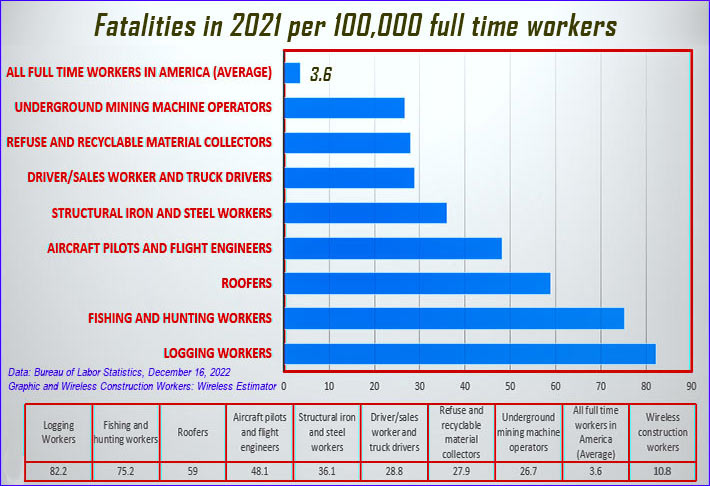
It took almost two decades, but the wireless construction industry went from “the most dangerous” occupation to one that company owners, their employees, NATE, and industry stakeholders transformed into one of the safer professions in the U.S. Wireless worker deaths, based upon approximately 36,000 employees, totaled 10.8 per 100,000 workers. The BLS used to identify the top ten professions with fatalities, but in 2021 reduced, it to eight, with the lowest being 250% higher than wireless construction.
Commentary — In 2006, after exhaustive research, Wireless Estimator identified cell tower climbers had the most dangerous job in America, exposing a death rate per 100,000 workers of 115.2 based upon approximately 8,700 workers within the industry. The data was obtained, in part, from the Bureau of Labor Statistics (BLS) lagging 2004 data, based upon ten fatalities, later revised to 11.
The data released for 2005 showed fatalities had declined to 7. NATE: The Communications Infrastructure Contractors Association and OSHA welcomed the news, and both organizations attributed the lower fatality count, in part, to a working relationship.
However, in 2006, the industry’s report card was appalling when 18 fatalities occurred, later revised to 19 upon further research. It equated to a death rate of 183 per 100,000 workers. At the time, approximately 9,800 tower techs were working in the industry, not including an unknown count of 1099 workers.
At an Orlando, Florida NATE conference in 2008, Assistant Secretary of Labor of OSHA Edwin Foulke, Jr., said in prepared remarks, identifying Wireless Estimator’s research, that “tower climbing remains the most dangerous job in America.”
The Wall Street Journal looked into Wireless Estimator’s fatality claim. The newspaper provided tacit approval in 2008 for identifying cell tower workers as having the “most dangerous” job in America.
In 2012, ProPublica and Frontline tackled a year-long investigation that resulted in an article and TV program primarily sparked by the statistics.
A couple of decades of self-policing, revised standards, and education were the model for change
With most wireless contractors adopting a safety culture with their employees’ buy-in through training and support and NATE and other organizations’ outreach, wireless construction is no longer included at the top of the most dangerous jobs list.
Based upon BLS statistics released in December for 2021 fatalities, the industry is one of the safer professions, with only 10.8 deaths per 100,000 workers based upon approximately 36,000 workers within wireless construction. In 2022, wireless construction dropped to 8.3 deaths per 100,000 workers.
The industry’s goal is to reach zero, and it’s possible soon, as NATE focuses on multiple outreach fronts with OSHA, the industry’s most qualified subject matter experts, and the overwhelming industry support of the NATE STAR Initiative.
For example, at NATE UNITE 2023 in Orlando last week, there was an undercurrent of concern regarding a fatality in December caused by a failed hoisting grip. As a result, many subject matter leaders and stakeholders informed Wireless Estimator that they immediately began researching the best way to address the issue and prevent it from happening again.
Some media and others didn’t get the improved safety memo
Unfortunately for wireless construction, the most dangerous label continues to get promoted in describing the industry. OSHA is one of the biggest offenders.
Last week, it was announced that OSHA expects to issue a Notice for Public Rule Making (NPRM) for a wireless construction industry-specific standard by March that OSHA provided in a request for information eight years ago.
In providing the NPRM background and its impetus, OSHA explained, “While the number of employees engaged in the communication tower industry remains small, the fatality rate is very high. Over the past 20 years, this industry has experienced an average fatality rate that exceeds that of the construction industry.”
This week, the false, ambiguous, at best statement appeared in multiple articles.
Taking a 20-year average is disingenuous, and OSHA Directorate of Construction Director Scott Ketcham should know that it is.
CWA saddles up to industry fatalities
Fatalities are vital in promoting the Communications Workers of America (CWA) Tower Climbers Union, which has one company office of approximately 12 climbers that won formal union representation since it targeted the industry.
Last May, the union, which has the ear of the Biden administration, released a private video highlighting fatalities and safety risks, ignoring the safer trend over the years, especially in 2022.
In a 2022 press release, the CWA said tower climbing was “the most dangerous job in America” and that becoming a union shop could “ensure a safer workplace.”
If unions provide a safer environment, the questions that beg to be answered are why structural iron and steel workers, mainly represented by unions, had the fifth highest fatality rate of all professions in the nation in 2021, why OSHA hasn’t published an RFI to assess how they can mitigate their 36.1 deaths per 100,000 workers in 2021 and why their fatalities have risen for the past three reporting years?
— Craig Lekutis
Correction: A lower fatality rate per 100,000 workers for wireless construction was revised to 10.8 for 2021 and 8.3 for 2022.

















